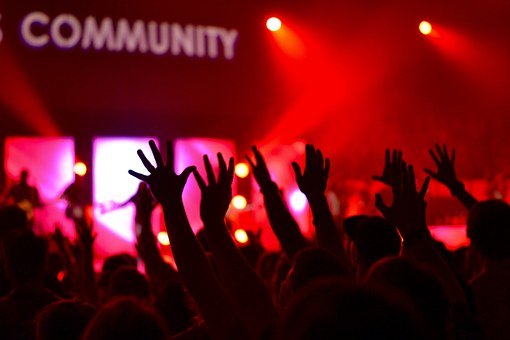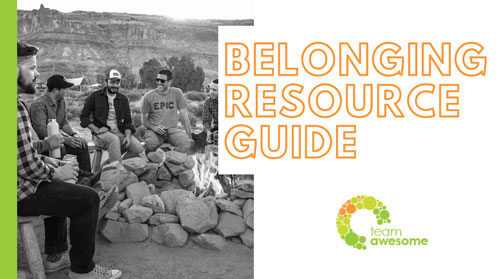For the past two years, I have been fixated on the topic of belonging. I have asked questions and searched for answers to queries like, what does belonging feel like? What needs to happen for belonging to exist, and what gets in the way? I have done some deep reading on the topic of belonging and adjacent topics like community, psychological safety and vulnerability. I can say for certain that it is a complex idea.
In this quest for understanding (and for belonging itself, in many ways) I have had the joy of wrestling with this topic with a lot of friends, colleagues, mentors, and all-around smart people. And I have learned a lot through other peoples’ stories, disagreements and added complexities. Here are some of the latest nuances of belonging that I have come to understand, along with some reassurance of what I have already believed to be true.
Crisis of Connection
Right now, there is a crisis of connection, and I believe work can (and should) play a role to fix that. Our workplaces, based on sheer time and energy that we spend there, must be part of the solution, and they pose a unique opportunity to support the humanity that works for us every day. If we begin to view our roles as leaders in the organization differently to support belonging, we could revolutionize our experience of work.
Defining Belonging
I will admit, that I have never yet really committed to one definition of belonging. I have talked more about what belonging feels like, what it looks like, what gets in the way. But I have never landed firmly on a single, simple definition. To begin to do this, I considered a lot of words that are associated with belonging, many of which you can see below here.
- Relationship
- Trust
- Alignment
- Connection
- Absence of fear
- Sense of shared identity & values
- Fully able to be yourself
- Wholeness
- Safety
- Commitment
- Investment
As a result, below is a working definition of belonging to consider. It’s not perfect or complete, but it will help us use a common language of belonging here.
Belonging is the magic that occurs at the intersection between the authentic identities and commitments of the group and its members.
Let’s break that down into the critical components.
Magic: This is meant to denote that true belonging feels a but mystical and elusive, as if 2+2 does not have to equal 4. It feels aspirational and indicative of what true belonging feels like.
Intersection: This means that there is a role to be played by each individual, and the group as a whole. Both parties must be actively engaged in order for belonging to sprout.
Authentic identities: Individuals must be able to bring their whole selves and be secure in their own unique, authentic identities. The group needs to be clear and authentic on what their identity is, what they value and how they show up day in and day out. Culture is a collection of tiny moments.
Commitments: Individuals must contribute to the whole, and feel as if they have ownership, responsibility in the group. Organizations must clearly create the container and safety that belonging needs, and remove roadblocks for membership, safety, or wholeness.
The Work
The bottom line: both individuals and the organization must take active roles in belonging.
We cannot individually show up to our workplaces and expect a sense of belonging to be fully managed for us. Nor can we as leaders of organizations continue to ignore the inconvenient truth that our employees are in dire need of our support of their humanity, both at work and on their own time.
If we find ourselves on both sides of the coin (and most of us will), that means that we will need to work at creating belonging with ourselves and simultaneously working to make work a place that feels safe for people to connect and bring their whole selves. Here is how we may best begin to show up for ourselves and others in our community of work.
Our Individual Responsibility
We have to belong to ourselves in order to belong to others. (Dominique Samari)
So many of us (and for a long time, myself unwittingly included) fly through our days feeling stressed, overwhelmed, and barely able to take care of our own, much less worry about anyone else. We see evidence of this in the line at the grocery store, or in the distracted, empty attention that we give to one another in meetings. Or course I can’t fault any of us for that, it makes perfect sense that we can barely keep our own shit together given all of the competing priorities in our lives. But let this moment stand as the beginning of an awakening to the idea that finding safety and peace within yourself is the first step to have the capacity to think about and create belonging for others.
Our role is to choose every day to belong to ourselves, and to be part of a community. We must do what it takes to find safety, comfort, and peace in your own authentic identities. Each of us has to eradicate fear, so we can squarely belong to ourselves. I find it easiest to tap back into earlier times in my life when I truly felt like I belonged. Sure enough, at the same time I felt totally comfortable in my skin, excited about my contributions. I didn’t live in fear and questioning. I tap into what that felt like, and work to recreate it in the current tense.
We also must be willing to invest in, take ownership of, and assume responsibility in the community to which you belong. You have to have some skin in the game of maintaining the ecosystem that is your community at work. Otherwise you are basically just attending a conference.
We only ever know fragments of people, or of ourselves. (Stuart Chittenden)
When my friend Stuart said this out loud for my ears to hear, the truth of it broke something open in me. As someone who often struggles to share pieces of myself or who continues to understand new nuances about myself that I hadn’t understood earlier in life, I found this to be profoundly true. And connection, where we see others and feel seen, is easily one of our most precious and increasingly rare resources. This is the most simplistic (yet not easy) equation for belonging. Know ourselves, and know others.
The Role of Organizations
In the workplace, it seems to me that we have two core needs: purpose and belonging. So how do we decipher which is what? Purpose generally relates to the work, and belonging is relational, relating to people. We need both. We could go to work and feel belonging and not actually create any output of value, or we could constantly be conducting meaningful work and feel utterly alone while doing it. Because belonging is relational (it takes the willing collaboration of others to exist), it is more complex and elusive at work.
I believe we have a responsibility to foster belonging in our organizations. Work is such a large part of our lives, that if work does not contribute to creating connection and belonging we will be hard pressed to get enough of it in our lives. I see three components that companies can affect.
First, we can build our workplaces, our leadership training, and what we measure for belonging. In the past, companies have built for productivity, measured for diversity, and actual outcomes were some sad “Door #3.” If we build work with belonging as the goal, the lens we use, then we could teach leaders these skills and expect them to create a culture of belonging every minute of every day.
Second, organizations can commit to removing layers of BS or other policies, procedures, red tape, or anything else that gets in the way of belonging. We must simplify things to support humanity. We build things for the benefit of the humans that work for us, and we remove behaviors and systems that cause roadblocks or belonging erosion.
Finally, when we look at the future of work and see the importance of learnability, training, and individual development as a key factor, organizations can also support individuals to help them belong to themselves. I have already argued that one must belong to themselves to have the capacity to belong to each other. Companies can offer resources that help people feel firmly planted in themselves, and then honor each other for showing up as their whole selves.
In simplest terms, we have to do our own work to be at peace with our whole selves. We have to put forth effort and commitment to the community we choose to be a part of. And organizations have a responsibility to support us in our personal growth, to remove roadblocks to belonging, and to build and measure the organization with a lens of belonging.
Are you up for the task? I know that I am.
Resources
Keynote topic:
If you are interested in the topic of belonging for your leaders or organization, you can find information about my signature keynote on belonging here.
Suggested further reading:
Community: The Structure of Belonging, by Peter Block
Our Search for Belonging: How Our Need to Connect Is Tearing Us Apart, by Howard J. Ross
About the author:
Katie Rasoul is a keynote speaker, author, coach and Chief Awesome Officer for Team Awesome, a leadership coaching and culture consulting firm. She is a TEDx speaker alumna, author of the best-selling book, Hidden Brilliance: A High-Achieving Introvert’s Guide to Self-Discovery, Leadership and Playing Big, and co-host of The Life and Leadership Podcast.
Find out more by visiting www.katierasoul.com and www.teamawesomecoaching.com or join the Team Awesome Community for awesomeness coming straight to your inbox. Follow Team Awesome on Instagram, Facebook and Twitter.



Recent Comments